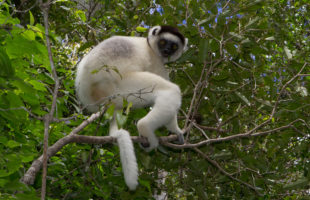Angavokely and Angavobe: The names Angavokely and Angavobe mean “few bats” and “many bats”. The names refer to the caves of the protected area where the harmless fluttering animals live. Location: The park of Angavokely and Angavobe is located only 36 km east of the capital Antananarivo. With a car and driver, it takes about one to two hours to …
LesenSchlagwort-Archiv: dry forest
The climate in Madagascar
Madagascar is an island with many faces and also with the climate this saying is more than true. Madagascar’s climate is dominated by the Indian Ocean, which sends trade winds throughout the year. These meet in Madagascar with different cave locations, protective mountain ranges, and unprotected offshore islands, which create very different climates. The dry and rainy season The climatic …
LesenThe Ankarana Sportive Lemur
Sportive Lemurs are everywhere in Madagascar. But every place has its own species. In the far north of Madagascar, in the dry forests of Ankarana, lives the eponymous Ankarana Sportive Lemur (Lepilemur ankaranensis). It is widespread as far as the nearby rainforests and dry forests of the Amber Mountain as well as Analamerana and Manongarivo and is only about 25 …
LesenThe Ground Gecko of the South: Paroedura picta
The hot south is the home of a small and very pretty gecko, the Madagascar Ground Gecko (Paroedura picta). It inhabits spiny and dry forests around Toliara (French: Tuléar) down to the bay of St. Augustin. The somewhat wetter valley along the river Onilahy is also populated. Even further south the species occurs as far as Berenty and Amboasary Sud …
LesenCuvier’s Madagascar Swift: Oplurus cuvieri
It actually isn’t really big, but at least clearly the biggest in its family: The big Cuvier’s Madagascar Swift (Oplurus cuvieri) measures a maximum of 38 cm from the nose to the tip of the tail. Alone the scaly tail constitutes good 20 cm of it. Cuvier’s Madagascar Swift belongs to the family of the Madagascar iguana, that there is …
LesenTavy – Clearing an island
Black smoke clouds the national route 2, the off-roader brakes and continues at snail’s pace. The driver hurries to close his window. “What’s that?”, asks a traveler in the back seats. “The forest is on fire,” mumbles the driver. “We call it tavy.” This or something similar happens every day in Madagascar. But why is the rainforest burning next to …
LesenAnkarafantsika national park
Ankarafantsika: The word itself means “spiny mountains” and alludes to the famous gorge of the park. Ankarafanstika is also called “the Kingdom of Birds“. Location: Ankarafantsika National Park is located in northwestern Madagascar in the Ambato Boeny region. It is located 420 km north of Antananarivo and 115 km west of the port city of Mahajanga. The RN4 connects both …
LesenKirindy reserve
Kirindy: The word Kirindy means as much as „dense forest with wild animals“. Due to the more south located national park Kirindy-Mitea, the reserve is also known as “Kirindy Nord”. From former times it has the name “La forêt des Suisses”, the Swiss people’s forest. Location: Kirindy Forest is located in western Madagascar in Menabe region. From the capital of …
LesenThe left-handed lemurs: Coquerel’s sifakas
With their typical teddy bear-like appearance, they wrap many travellers around their fingers: Coquerel’s Sifakas (Propithecus coquereli) wear a plush, snow-white fur, whereby the upper sides of the arms and thighs as well as the chest are deeply chocolate brown colored. With up to a half meter head-torso-length – in addition, another half meter tail – as well as approximately …
LesenZombitse-Vohibasia national park
Zombitse-Vohibasia: The compounded name of this national park derives from two of three areas belonging to the park. Zombitse means as much as „dense forest“ and thus names the dry forest of the national park. Vohibasia is the savannah in front of this forest and means „hill of pistols“, which is attributed to conflicts between the people of the South …
Lesen MADAMAGAZINE Your Magazine about Madagascar
MADAMAGAZINE Your Magazine about Madagascar










